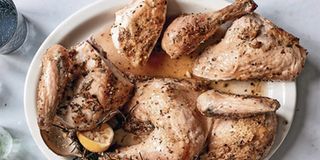Flavour chicken, fish and beef without using salt

A plate of chicken serving. Generally, the effect of sodium on food flavour is great, however having less sodium in the diet helps lower or avoid high blood pressure.
What you need to know:
- When there’s extra sodium in your bloodstream, it pulls water into your blood vessels, increasing the volume of blood inside.
- Sodium is abundant in many diets. While some sodium intake is necessary, there are recommendations for adequate intake and tolerable upper intake levels.
- Most of the sodium in our diets comes from adding salt when food is being prepared. For processed food, pay attention to food labels because they tell how much sodium is in food products.
- To flavour rice, you can add a teaspoon of mustard seeds when you put it to boil or add two teaspoons of chopped parsley or a pinch of saffron or when the rice is cooked, add diced lightly fried onions with curry powder.
Sodium is essential for physiological functions of the body and cellular homeostasis. Excess dietary sodium has, however, been associated with high blood pressure.
When there’s extra sodium in your bloodstream, it pulls water into your blood vessels, increasing the volume of blood inside. With more blood flowing through your blood vessels, blood pressure increases.
Some people tend to be more salt-sensitive thus extra sodium in the bloodstream may lead to high blood pressure.
Having less sodium in the diet, therefore, helps lower or avoid high blood pressure. People with high blood pressure are more likely to develop heart disease or have a stroke.
Sodium is abundant in many diets. While some sodium intake is necessary, there are recommendations for adequate intake and tolerable upper intake levels.
Generally, the effect of sodium on food flavour is great. Thus, many people eat too much without knowing it.
Most of the sodium in our diets comes from adding salt when food is being prepared. For processed food, pay attention to food labels because they tell how much sodium is in food products.
The sodium-containing compounds to limit in the diet include salt (sodium chloride or NaCl), monosodium glutamate (MSG), baking soda and baking powder, disodium phosphate and any compound that has ‘sodium’ or ‘Na’.
High in sodium
Pre-packaged, processed and prepared food items tend to be high in sodium.
Read food labels and chose the lowest level of sodium for these food items.
Choose more often:
“Convenience foods” that are lower in sodium, like: Fresh poultry, fish, and lean meat, rather than canned or processed types.
Fresh, plain frozen or canned vegetables with no salt added. Low or reduced sodium or no salt added versions of foods. Ready-to-eat breakfast cereals that are lower in sodium, such as shredded wheat.
Unsalted nuts.
Choose less often:
Canned fish like tuna, salmon, sardines and mackerel. Canned soups and instant soups.
Frozen dinners, pizza, packaged mixes, canned soups or broths and salad dressings. These often have a lot of sodium.
Instant or flavoured cereal mixes, which usually have added salt.
Most cheese spreads and cheeses. Quick cooking rice and instant noodles, boxed mixes like rice, scalloped potatoes, macaroni and cheese, pot pies and pizza.
Regular canned vegetables. Salty chips, nuts and pork rinds.
Smoked or cured meats like bacon, bologna, hot dogs, ham, corned beef, luncheon meats and sausage.
Soy sauce, steak sauce, salad dressing, ketchup, barbecue sauce, garlic salt, onion salt, seasoned salts like lemon pepper, bouillon cubes, meat tenderizer, and monosodium glutamate (MSG).
Flavour chicken without using salt
Add fresh curry (soft) leaves towards the end of cooking. For roast chicken, pierce the flesh and add pieces of fresh garlic and rosemary.
Marinate chicken breasts or pork chops in lemon juice or orange juice.
Marinate chicken in ground ginger and garlic, ground cumin and coriander and gram masala powder overnight before cooking, for example, a tikka chicken curry.
Marinate the chicken in honey, mustard and lemon juice overnight, then grill
Use cooked pureed red pepper as a substitute for tomatoes or tomato puree.
Adding flavour to fish
Add fresh or dried dill to baked fish (especially with salmon).
Roll fish in sesame seeds before baking.
Sprinkle drops of lemon juice, paprika, finely sliced onion and red or green peppers before baking.
Adding flavour to beef
Spice up beef with a mixture of onion, peppers, sage, and thyme.
Adding flavour to vegetables and starch dishes
Finely diced fresh rosemary with freshly ground garlic adds a lot of flavour to baked potato or sweet potato.
Fresh mint added to a salad.
Simmer carrots in cinnamon and nutmeg.
Soak sliced cucumber in balsamic or grape/apple vinegar, and ground black pepper.
Sprinkle some dill and parsley or diced (chopped fresh rosemary) onto potatoes before roasting.
Sweet potato mash: blend/mash cooked sweet potato, with spring onions, cooked carrot and garlic.
To flavour rice, you can add a teaspoon of mustard seeds when you put it to boil or add two teaspoons of chopped parsley or a pinch of saffron or when the rice is cooked, add diced lightly fried onions with curry powder.
Toss your pasta with fresh chopped garlic and with fresh diced basil or dried basil or dried/ fresh oregano.
The writer is based at the Department of Human Nutrition, Egerton University.




